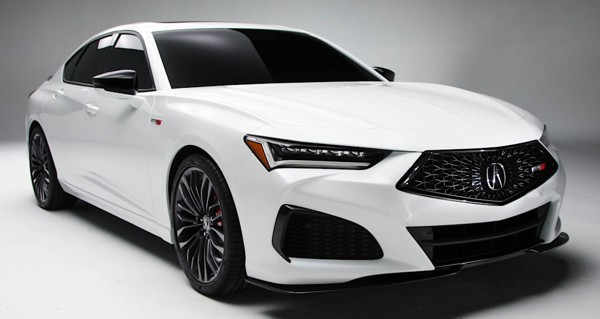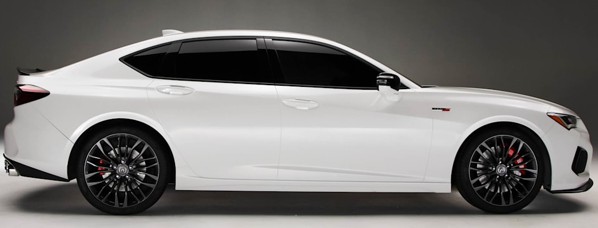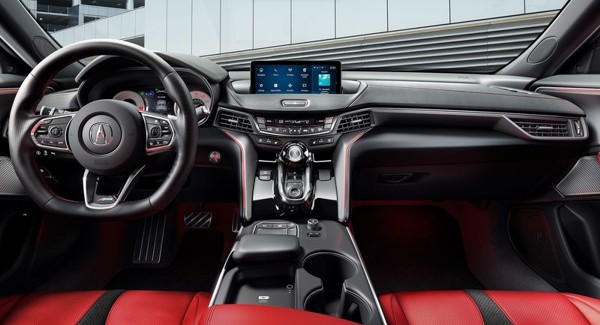
| 29 May, 2020 |
| Acura TLX
goes turbocharged |
 The first all-new car launched during pandemic arouses AutoZine from sleeping mode. This is the second generation Acura TLX, or the 5th generation if you take its predecessor TL into account. It is Honda's challenger to BMW 3-Series, although for so many years its Accord-derived front-wheel-drive platform failed to materialize that promise. The new generation is again built on a front-wheel-drive, transverse-engined platform, but it deviates a lot from its Honda siblings. As you can see from these pictures, its proportion is closer to a conventional rear-drive car. The cabin is pushed rearward thus the bonnet is much longer than the norm of FWD cars. Tape measurement doesn't lie - the new car has its front axle pushed 200mm further away from the dashboard mounting point. The wheelbase is stretched by 95mm to a generous 2870mm, while the body gets 55mm wider and 15mm lower for a sportier proportion. Front and rear tracks are widened by 30 and 40mm, respectively.  The chassis is primarily made of steel, but a lot of parts up front have been converted to aluminum, such as bonnet, fenders, bumper beam and the cast aluminum supsension tower brackets. Furthermore, the battery has been moved to the trunk to improve weight distribution. Honda said the front-drive base model has a weight distribution of 57:43 front to rear, not bad. Opting 4WD can only improve this figure, although the range-topping V6 engine will do the opposite. The body is said to be the stiffest in Honda's lineup bar the carbon-fiber NSX. Compared with the old car, it is 50 percent stiffer in torsional rigidity, or even 100 percent around the suspensions. Speaking of suspension, it is also a key improvement, as the front has been upgraded from the old car's MacPherson struts to a double-wishbone setup. Adaptive dampers are optional. Strangely, the rear-wheel steering option of the old car is omitted this time around. The range-topping Type S employs 20-inch wheels shod with 255/35R20 rubbers which offer 20 percent more grip than those of the old car. The brakes are now controlled by wire, and the Type S features 4-pot Brembo front calipers.  Performance is also significantly improved. While the outgoing TLX relied on all naturally aspirated engines (206hp 2.4-liter four or 290hp 3.5-liter V6), the new car makes do with turbocharged 2.0-liter four or 3.0-liter V6. The former is a tuned verison of the one using on Accord. It features DOHC and VTEC cylinder head as well as direct injection, producing 273hp and 280 lbft of torque. Meanwhile, the V6 is reserved for Type S. Its output is yet to be finalized, but Honda promises a dramatic increase over the outgoing 290hp, so you can expect mid to high-300 horsepower, and way more low-down torque of course. Unlike the V6 motor of NSX, it runs a conventional 60-degree V-angle and features a single turbo, albeit with twin-scroll. Honda promises a compact package, so I suspect it employs a hot-V architecture like Audi's V6. Both engines mate with a 10-speed automatic - sadly, no more manual or twin-clutch gearbox option for purists. The four-cylinder engine drives the front wheels as standard but can be optioned with SH-AWD system, which is compulsory on the Type S, predictably.  The 4th generation SH-AWD is believed to carry over the basic architecture of its predecessor, which means it uses a pair of electrohydraulic clutches to engage individual rear wheels. As before, it may send up to 70 percent torque to the rear axle under normal condition (i.e. without tire slipping at the front axle), and all of that torque to either rear wheels. However, since the turbocharged engines are a lot torquer, Honda has strengthened the design, offering 40 percent higher torque capacity to the rear axle and 30 percent quicker front-to-rear torque transfer. The latter is made possible by overdriving the rear axle by 2.9 percent, compared with 2.7 percent on the old car. Inside, the new TLX emphasizes a sporty rather than luxury design theme which has strong family resemblance with NSX. However, the problem is, will the market accept the idea of a front-wheel-drive based sports sedan? Now even the Korean has turned to rear-wheel-drive for their premium sports sedans (Genesis G70 and Kia Stinger), is there still space for this Acura to survive? |
| |
